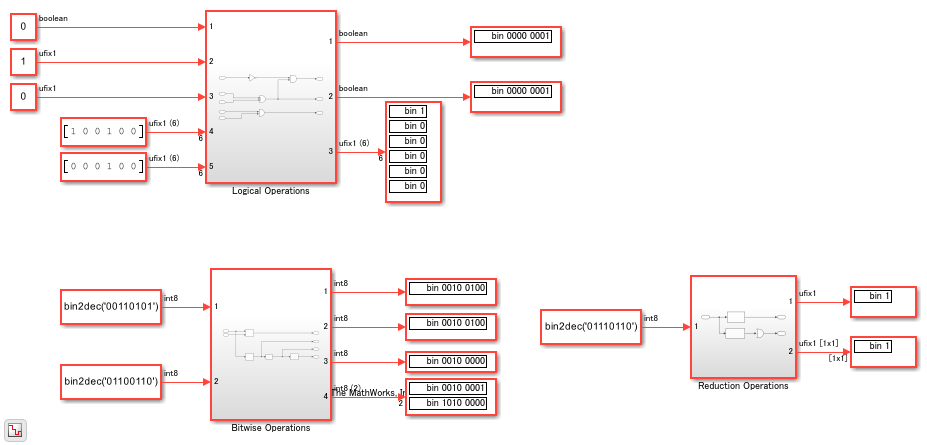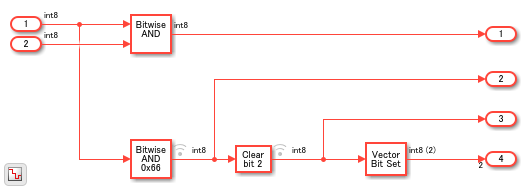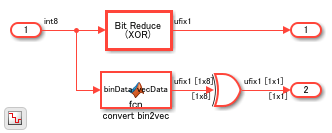Usage of Blocks in Logic and Bit Operations Library
These guidelines illustrate how to model your design for generating HDL-ready code from blocks in the Logic and Bit Operations Library. The Library contains blocks that perform logical and bitwise operations, bit reduction, and concatenation. Each guideline has a severity level that indicates the level of compliance requirements. To learn more, see HDL Modeling Guidelines Severity Levels.
Logical and Arithmetic Bit Shift Operations
Guideline ID
2.2.1
Severity
Informative
Description
You can use Simulink® blocks to perform bit shifting operations. The blocks can perform logical and arithmetic bit shift. Left logical and arithmetic bit shift produce the same results but right logical shift and arithmetic shift operate differently as illustrated in this table.
| Block/Function Name | Parameter/Operation | Verilog or SystemVerilog Code Equivalent | VHDL code equivalent | Comments |
|---|---|---|---|---|
| Bit Shift | Shift Left Logical | <<< | sll (sll and
SHIFT_LEFT are the same in VHDL. | This mode is the default mode for the block. The left shift
operation does not preserve the sign bit. If the input uses a
signed data type and has a positive value, the left shift
operation shifts a 0 into the empty bit on
the LSB (Least Significant Bit) side. |
Shift Right Logical | >> | srl | This mode does not preserve the sign bit. If the input uses a
signed data type and has a positive value, the right shift
operation shifts a 0 into the empty bit on
the MSB (Most Significant Bit) side. | |
Shift Right Arithmetic | >>> | SHIFT_RIGHT | When the input is a signed data type, the sign bit is preserved, and other bits shift to the right. | |
Shift
Arithmetic block bitshift
function | Positive value/shift right arithmetic | >>> | SHIFT_RIGHT | When the input is a signed data type, the sign bit is preserved, and other bits shift to the right. |
| Negative value/shift left arithmetic | <<< | sll | This mode does not preserve the sign bit. If the input uses a
signed data type and has a positive value, the left shift
operation shifts a 0 into the empty bit on
the LSB side. This mode does not check underflows and
overflows. | |
bitsll function | None/logical left shift | <<< | sll | This mode does not preserve the sign bit. The generated HDL
code is the same as that of the Shift Left
Logical mode of the Bit Shift
block. |
bitsrl function | None/logical right sift | >> | srl | This mode does not preserve the sign bit. The generated HDL
code is the same as that of the Shift Right
Logical mode of the Bit Shift
block. |
bitsra function | None/arithmetic right shift | >>> | SHIFT_RIGHT | When the input is a signed data type, the sign bit is
preserved, and other bits shift to the right. The generated HDL
code is the same as that of the Shift Right
Arithmetic mode of the Bit
Shift block. |
The difference between a logical shift and an arithmetic shift is whether the sign bit is preserved. For signed data types, this bit is the MSB. In a logical right shift, the sign bit is shifted to the right and zero goes into the MSB side. In an arithmetic right shift, the MSB (sign bit) is preserved during the shift operation. For example, this code illustrates the difference between the functions.
A = fi([], 1, 4, 0, 'bin','1011'); B = bitsrl(A, 2)
B =
2
DataTypeMode: Fixed-point: binary point scaling
Signedness: Signed
WordLength: 4
FractionLength: 0B.bin
ans =
'0010'C = bitsra(A, 2)
C =
-2
DataTypeMode: Fixed-point: binary point scaling
Signedness: Signed
WordLength: 4
FractionLength: 0C.bin
ans =
'1110'
Usage of Logical Operator, Bitwise Operator, and Bit Reduce Blocks
Guideline ID
2.2.2
Severity
Informative
Description
For an example of logical and bitwise operations, open the model hdlcoder_logical_bitwise_operations.slx.
load_system('hdlcoder_logical_bitwise_operations') sim('hdlcoder_logical_bitwise_operations') open_system('hdlcoder_logical_bitwise_operations')

For single-bit operations that use Boolean or ufix1 data types, use a Logical Operator block. To view the operation as a logical circuit symbol, in the Block Parameters dialog box of the block, specify the Icon shape as Distinctive. You can also input vectors that have Boolean or ufix1 data types to the block.
Boolean and ufix1 are different data types. Avoid using both data types within the same model, or using them interchangeably. See Simulink Data Type Considerations.
For an example of using the block, open the Logical Operations Subsystem.
open_system('hdlcoder_logical_bitwise_operations/Logical Operations')

For bitwise operations on two or more bits that use integer or fixed-point data types, use the Bitwise Operator block. For an example, double-click the Bitwise Operations Subsystem.
open_system('hdlcoder_logical_bitwise_operations/Bitwise Operations')

To perform a bit-by-bit reduction operation on a vector that uses Boolean or ufix1 and return a 1-bit value, use the Bit Reduce block. For an example, double-click the Reduction Operations Subsystem.
open_system('hdlcoder_logical_bitwise_operations/Reduction Operations')

The MATLAB Function block inside the Subsystem converts the 8-bit vector to a vector of 8 1-bit ufix1 elements.
open_system('hdlcoder_logical_bitwise_operations/Reduction Operations/convert bin2vec')
Use Boolean Output for Compare to Constant and Relational Operator Blocks
Guideline ID
2.2.3
Severity
Strongly Recommended
Description
For Compare To Constant, Compare To Zero, and Relational Operator blocks, you
can specify uint8 or boolean as the
Output data type. To generate efficient HDL code for
models that contain these blocks, specify boolean as the
Output data type, because the HDL code has to connect
only the LSB.
For a Relational Operator block, make sure that both inputs are of the same data type. Using different data types for the inputs can result in unintended truncation of bits such as the sign bit, which can lead to simulation mismatches after HDL code generation.
To verify whether Relational Operator blocks in your model use
the same input data type, and use boolean as the output data
type, run the HDL model check Check for Relational Operator block usage.